How to make a retail-ready card game! Simplified stages for creating the game. The stages used to make a retail-ready card game could be assumed to be universal. However, I feel that could be do broad and ‘assuming…’ Also, to those who are interested, here is some information on my new game consultation service. “We didn’t want to leave it to chance“ It was not an accident that Mouth Trap was created and sold to 1000’s of copies in shops across the globe. I was unconvinced… He proceeded to open a tab in his browser and play a clip of the television program. Without paying too much attention to the idea, I dismissed it at first. Thinking it was a game, only people like me and him would play. But he persisted with the idea. I was half right, but
little did I or the company realise how popular it would be.
After seeing James Corden trying to speak with one of these dental mouth restraints in his mouth, we came to the conclusion it could be funny if it were boxed and ‘gamified’ for a consumer market in the UK. We created something that followed a trend but was different enough to stand out from what would become a busier crowd. My part in the project involved the visual design, collaborating to create the cards and their contents, the box cover, and playtesting the game. Here is another example playtest for another project. You need to do homework. Without it, you are making something blind. Ever distancing your chances of hitting your retail success, whether you base this on popularity or consumer sales. I have come to learn that there are different demographics in the board game community. These 2 demographics can also be extreme opposites in tastes within tabletop gaming. These are just some of the questions to ask when creating a retail-ready card game for the masses! Learn to appreciate your group! The game we created wasn’t revolutionary, but it took some lessons from other successes. Something you can take away – you don’t need to reinvent the wheel. Creating a game is a BIG decision. The volume of eager, fresh-eyed enquires I receive, thinking ‘it’s all fun and games’, is high. It is not long before I see bleary eyes and jaded tones trudging the midstages of a very big project, even when I try to keep clients motivated. Observe the greats, watch the audience, and plan your actions. We wanted to know who would buy this product and how we could be different. Retailers won’t care about your product as much as you do. Proving that your product follows a trend can put you in good standing, but be prepared to fight in a market that will saturate quickly. Trend chasing can be very advantageous in the short term, but challenging to sustain and fight in the long term. Stand on the shoulders of giants! See what they see. See what they do and consider what you can do from this great vantage point. The greats can offer a brilliant blueprint. But a downside to this is that it can hamper originality. Assuming you have gone with an existing product that has an established community and marketing buzz, creating an out-and-out copy won’t get you very far or last for the long-term. We brainstormed various ideas on how we could have different modes of gameplay. Alterations to rules, extra dynamics of the game, and remember to keep it low-cost. If you want to create a game that is successful in the retail market, you will need to have access to companies that can sell your game on your behalf. Or you may prefer to sell your product directly to the customer, but this is much harder to scale as a business. Some companies also adopt a hybrid approach of a wholesale business model and selling directly to customers. As a case study on how to make a retail-ready card game, or at least a successful one as illustrated throughout this post, I will focus on how this card game was sold. You may already have access to shops and stores that can sell your game, or you may aspire to sell the game yourself. But if you want to scale quickly, you will need to ‘wholesale’ your game. This game was sold via Hasbro, Robert Dyas, to name a couple of large high-street shops in the UK. Finding retail channels for new business can be tricky. Consider going to Expos and events. Look at Kickstarter campaigns to raise funds and awareness of your game. For those who are interested. I run a website dedicated to making tabletop gaming and the niche of making games. OR if you need help with your game design, take a look here : In order to make a good game, your product needs to be good. It is short-sighted to make a pretty but unplayable game. A crap game will prove it is crap once it is available to the market. The general public can also be ruthless with their opinions. Make sure to run playtests on your game first. As illustrated in this article. Our card game had become popular. We needed to create more content and quickly! Surfing the wave of this success, we created more content and more products. We created additional expansion packs, card decks, and different editions of the game to serve a hungry market for the game. The project was intense, but it was both a blast to make and the party game market liked it too. The game started to gain popularity and traction online from social media, to Amazon, to other forums, comments, and outlets. We looked at the reviews to see what we were doing well and what we weren’t. Some comments can be stinging to read! Others were throwaway opinions. Design by data. “Hilarious !! We had a great laugh looking at this when it arrived and can’t wait for Boxing Day with friends to have a game. One thing though, I had a cold when I first tried it and my lips were dry so they got sore, it may be worth putting a bit of Vaseline on before putting the trap in your mouth if you have dry lips” “Xmas pressie so not yet looked at” Create something people will enjoy. You want them to take away a good user-experience and feel happy with their purchase. No one wants to pay money for a game that is clearly a rip off and landfill. When I say keep it affordable, I mean keep it ‘accessible‘. Keep it affordable, does it need spot UV printing? No. By all means, keep the cost low, without compromising on the quality of the game. Use a ‘Minimum Viable Product’ – remembering not to insult the customer with your finished game by going too… ‘Minimum Viable Product’ Want to help ensure the longevity of your game for longer-term success? Please play test it. I have played a couple of board games over the years, which looked fancy but were either unplayable, unenjoyable, or and with poorly written or ill-considered rules. Even as an indie board game creator, you should aspire to make something that can at least be played and enjoyed. You are not selling art first. You are selling a board game. However, the art can be very important; it shouldn’t be a compensation for gameplay or game mechanics. If we were to make this game again. I would still try to make it enjoyable again. Although, do consider that what is fun for one person can be misery for another. Mouthtrap was initially tested on some peers and colleagues. This is better than no testing at all, but leaves plenty of room for improvement. Play tests allow you to develop core game mechanics in a safe environment. Don’t leave it to the general public to discover broken game rules and mechanics. Testing the game ‘only on you’ is the first port of call. But you will play your game as you expect to play it. People often play games in unexpected ways and interpret rules in a certain manner. You can read more on this article of working with Beta testers when playing a game. Need a hand with designing your game? When asking how to create a retail-ready card game, the end product matters if you want to strive towards success. The appearance matters if you want to be taken seriously. Want your product to resonate with target board game players and it matters in the marketing of your game. In certain scenarios, the appearance of your game matters more or less depending on the nature of your game. Retailers like a ‘professional-looking game‘. They want a game that they feel they can sell to their customers. They want an appealing product to place on the shelf and help sell a product. The retailer may also seek to find a product that is a brand or culture fit with their existing ranges. Likewise. Players want to look at the game. It needs to look better than something they could do themselves. Nothing too homebrew. Design can be a great thing for a product. Not just in appearance, but also in marketing and telling a part of a collective narrative in the game. Graphic design; I will say controversially, can also be used as a dark art. If you want longer-term success with your game. Don’t do this. I have played games that looked great but are unplayable. Don’t rely on graphic design as a gimmick to sell a weak product. A good example of a popular game is Chess. It has come in many guises over time, ranging from drinking editions to Harry Potter, but it still has the solid foundations of being a good game (open to opinion), which can be played over and over again. It needs no introduction. IF you were to design a piece of packaging for a chess game. It would only help to sell an already great game. It doesn’t need design to be used to disguise its shortcomings. Graphic design should be used to help sell an already strong product, not carry it. Fortunately for this game, we felt that it was fun for most before moving to the graphic design stages. This step covers some of the journey involved in creating the product. Creating cards, the logo, the box, the concept, the marketing material for the game… writing! The first box (edition
1) was created using a pizza box type Dieline. The later editions
came as a top and bottom box with a lid.
This was one of my favourite aspects of the game. Creating the cards. Later editions of the cards were changed so that phrases were on both sides. Visually, a little less appealing but offered better value to the customer and extended the length of game play. All design work on this post is copyright owned. Please do not take or use without prior permission. Okay, you got me. I am the owner of Dragon Bone Games.co.uk. A website all about making games, a niche gaming that you may find interesting to know a bit more about. Here are some links.
If you’re looking at how to create a retail-ready card game that you can sell to large retailers, this article covers the stages and strategies we used ( in my former role) to design and create a successful game.
This article is both a ‘how-to’ and a case study for those who are interested.
How we made a successful retail-ready card game … in steps
Steps Used To Create a Successful Game
This here is the process used to make THIS retail-ready card game. One that garnered excitement and earned my former employer a decent sum of money.

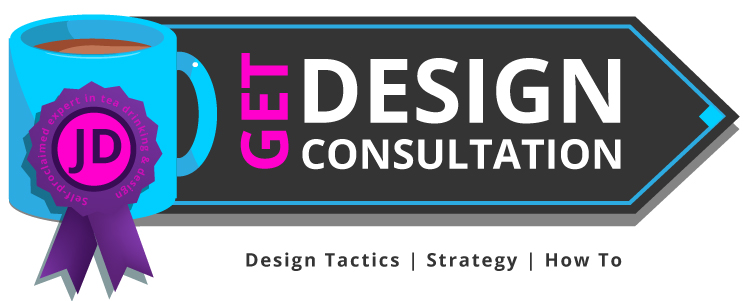
How to make a retail-ready card game – Why this game was made
After undertaking initial research into new product ideas, a colleague mentioned to me that he had seen a game where players had to say silly, tongue-twisting phrases whilst wearing a dental mouth restraint.
We went forward to create a successful card game! And what a blast we had creating it! Big Tip 1 ) How to make a retail-ready card game | Research, Research, Research
When creating a game you intend to sell in ‘big-retail’ make sure to undertake as much research as possible at the beginning.
For example, we wanted to know if there was an audience ready for the game, we didn’t want to to go the trouble of making the game – spending £ 1000s in company budget and time only to discover nobody wanted it, or that we had no way of selling it.
We didn’t want to leave it to chance.
Don’t just research aimlessly. Your research must carry an aim and purpose.Considerations for research when trying to make a card game for retail
When considering how to make a retail-ready card game, ensure you have a target demographic in mind, now design your game specifically for that group. It can be hard to please everybody.
Creating a ‘trend’ game with a difference
How you frame your project matters both emotionally and financially.
Board game development is a very costly commitment. You will want to see the fruits of your labour, even if you do have fun along the way!
A difference: When working with the team, we studied competitor websites, products, and online reviews. We collected our data and based our design and content decisions around the information we had collected.
This often fell in line with a process the company called NPD – (New Product Development)
We added our own style, created rude cards, included some playful forfeits, and developed add-on packs. It even went so far as to create an early proof-of-concept app, but that was shelved, sadly!Know This: Retailers won’t take stupid risks | Surfing a trend proved to be a wise move!
They don’t want headaches. They don’t want problems. How can they gain? Retailers want to know what supplying your product will do for them.
That is a blunt way of putting it, but largely true.Tip 2 ) Making A Game A Retail Ready Success | Learning from the greats ( stand on the shoulders of giants )
Setting aside legal issues, market saturation and being a grubby business practice, you will want to create something good and call it your own. Even if you take some inspiration elsewhere. 
Tip 3 ) Get access to gaming retail channels
You may find the post about: List of UK game expos useful. Or board game fulfillment companies. Tip 4 ) How to Make a Retail-Ready Card Game | Customer Validation
Observing what the audience said
End-users (customers on the street) were enjoying the game and sharing their joy and comments. This gave us a great sense of pride, we had created something that the world enjoyed.
Our product was making people happy! ( felt good about that!)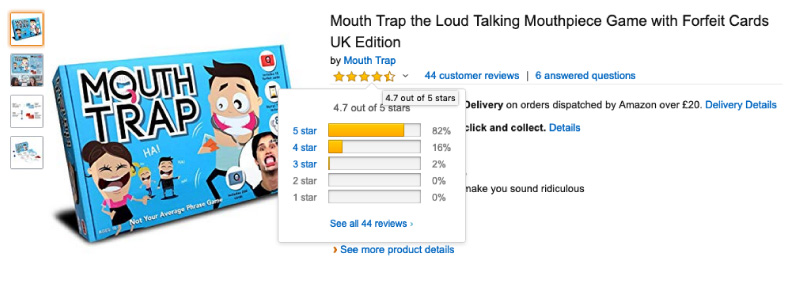
Tip 5 ) Keep it affordable
When we created this game, we wanted to create something that was good value for money. Adding more to production costs has a knock-on effect. When it comes to selling your game, and whether the end user can afford to buy your game, consider the final cost. This can have an enormous effect on the success of your game. The price point!
Will your cost reduction impact the gameplay? If no, then consider removing it.
The more you add to your game, the higher price you will have either pass on to the customer.
This game was between £15 – £20 for the minified edition of the game. Lower prices can also keep it affordable to a wider audience. IF you want to keep a premium version of your game, consider a travel version or a minified version also. Tip 6 ) We Play-Tested This Game! Again, and again…
Once the initial prototype of this card game was created. We tested the product and its phrases to see what worked and what needed improvement. You would be surprised by what you can discover in a play-test. Don’t do this – A hot t*rd wrapped in a shiny ribbon
The aesthetics of a board game are like putting the “cart before the horse” when it comes to making a card game or board game. You shouldn’t create a game that looks good but is terrible to play – people will feel duped!Example playtest for this successful card game
Game Consultation: Share your thoughts!

Tip 7 ) The appearance of the game is important to its success
Disguising a poorly constructed card or board game in ‘great graphic design’
Chess is a classic game. It can stand on its own two feet without being wrapped in a gimmick, as the foundations are already there. You can play it!
How to make a retail-ready card game | The Design Process –

Box net design for drinking edition game

Mini version of game
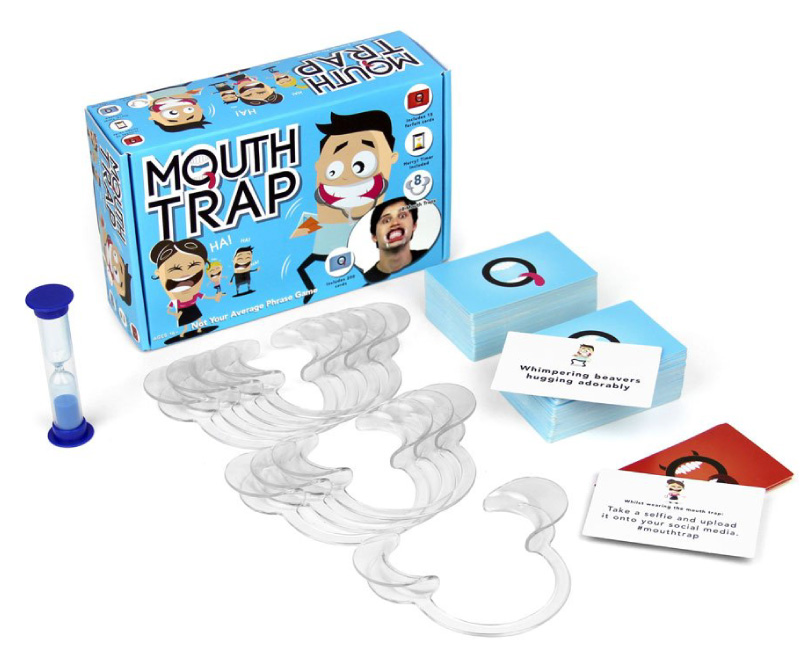

(Card Art

Piddle Pants Monk – Game Illustration


Why not start building your successful retail-ready card game!

How to make a retail-ready card game – Other helpful links
Other websites you may find interesting for making games
*All links lead to the 3rd party website.
My Creative Graphic Design Process | Explained In 7 Stages
Let me share my secrets.
For those who are interested in knowing more about my design process and workflow, this post is for you.
My creative graphic design process is explained in 7 easy-to-follow stages.
This post offers an inside look at how I approach design projects. From designing an eye-catching theme for a board game to creating a compelling landing page for a website, this step-by-step overview highlights my workflow and processes as a designer.
Design is a journey, and this is how I travel.
I advise anybody who is showing an active interest in working with me to take note of this post and try to read and consume as much of the information as possible. This post can also be hugely beneficial to those who have never worked with designers before and would like to understand the creative process.
For those of you new to working with designers, you may find this post interesting: What is a creative design process?
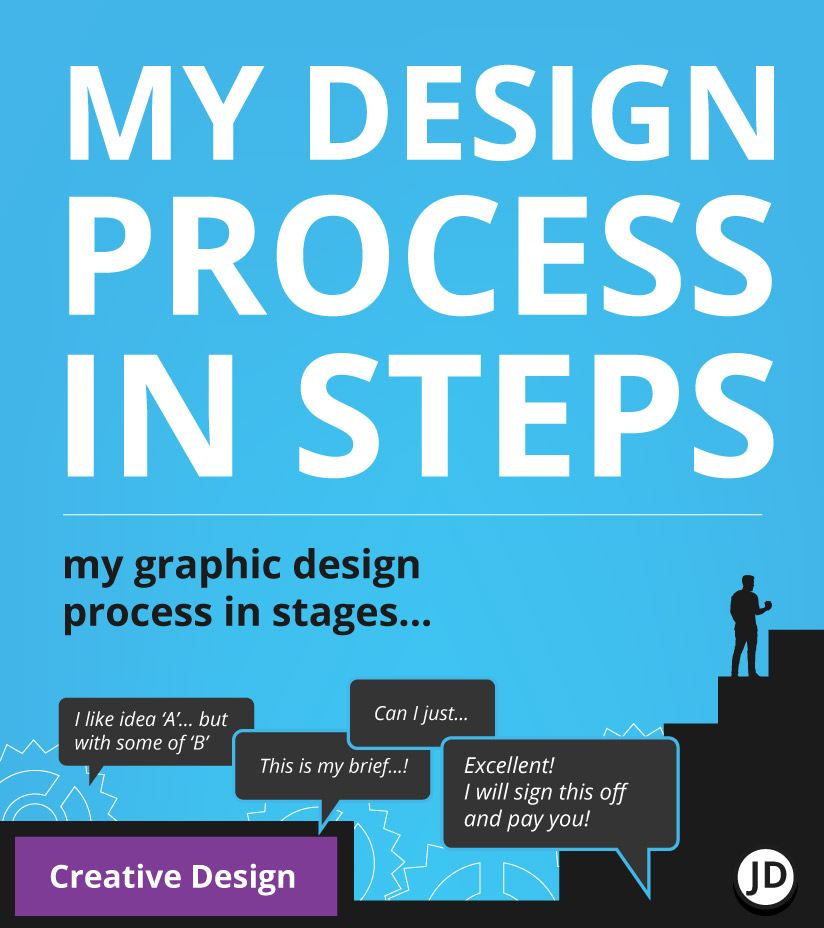
You also jump straight into the steps of my design process from here.
Now let me spill the beans and share my secrets…
How My Creative Approach Differs
I believe much of my design process is not too dissimilar to that of many other ‘creative’ and idea-based designers. However, I would also like to add that not all designers are the same. Our minds, education, and career paths can shape how we approach creative challenges.
I like to present myself as a ‘conceptual designer’ in a freelance and business setting. Offering ideas and solutions with a capable hand in delivering these ideas.
Having worked with a mixture of start-ups and companies with a history in product development, this has sculpted my approach and techniques when it comes to graphic design.
Does Graphic Design Have & Structure?
It should! Design for the most part, is applied and used in commercial environments. Be it for selling a product, an idea, or to convey some sort of message through the visual medium.
Graphic design can also play a pivotal part in the product itself. With this in mind, it should have some form of workflow and process and not be left to chaotic creativity alone. The creative process of design should, adhere to a structure that enables it to meet a brief with a precise outcome.
This need not inhibit creativity… On the contrary! A process can help the design with a mutually assured aim between the client setting the brief and the designer!
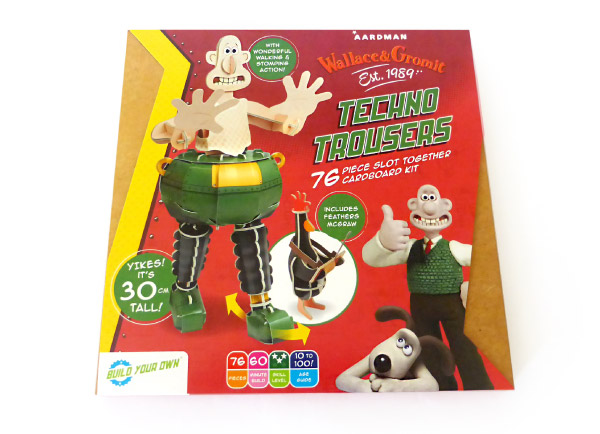
As an example, I have attached an image from the Aardman project were involved with. You can read more in the post.
My design process, whether for a board game, a crowdfunding campaign page, or digital content! Relies on a professional structure for both creating something that is ‘on brief’ and manages the project and client’s expectations in a piecemeal and controlled manner. As a designer and business owner, I try to avoid unexpected surprises.

My Creative Graphic Design Process – Table Of Contents
- ) Admin, set-up, learning brief
- ) Research, find Inspiration, collect data
- ) Early ideas, and very rough artwork
- ) Develop ideas
- ) Refine, polish, and finishing touches
- ) Final artwork sent for ‘final approval’
- ) Handover of artwork
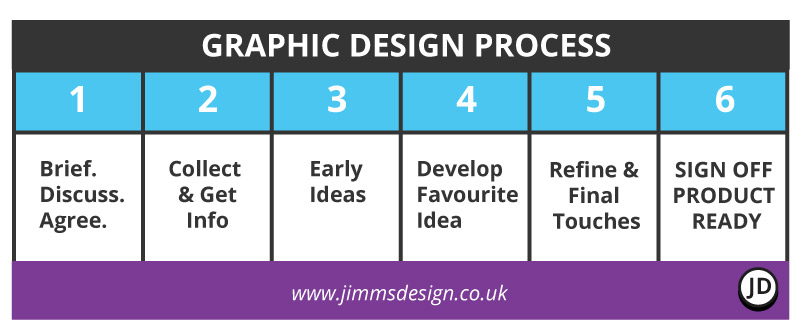
Infographic For My Creative Design Process
At the mid to latter stages of the creative process, a form of control is introduced that funnels decision-making.
At these junctions, I encourage the client to approve what is shown and discussed before proceeding with the journey. You can imagine this as a fork in the road or a crossroads in which I will also act as a guide and sherpa. This method enables me to put my best foot forward and enables the design direction to remain focused. ( We don’t want to veer too far off the beaten path! )
Please see my information graphic for this stage of my creative design process!
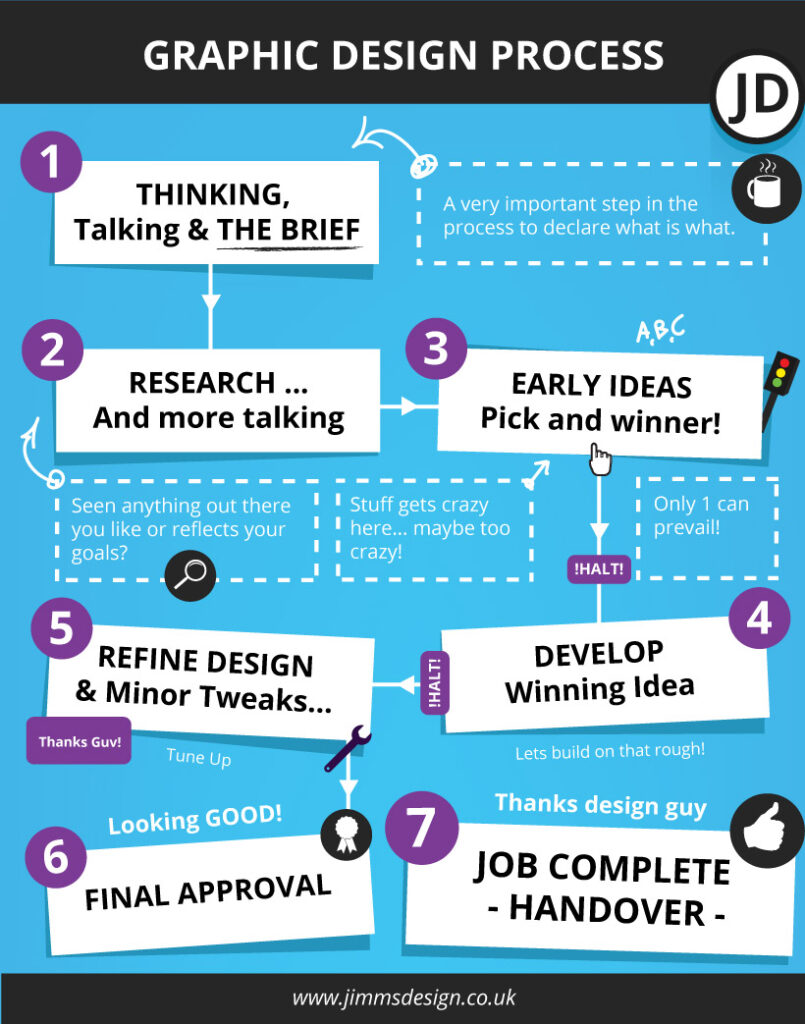
1 ) Getting To Know The Client – Admin & Project Set Up
This is a crucial step in the process as with the rest of the steps. This also forms part of the pre-preparation stage.
This very first stage – which could easily be called step ‘0’ – is where all paperwork is signed, and documents are filled. It is all part of the grand plan.
In this step, I will also try to learn more about the client, their business intentions, and their project.
At this stage, I may or may not have already spoken to a client based on an initial discovery call. This call is to learn more about you or them, and whether I can help with the project.
From this call, I will either advise and offer my paid consultation service first, which can save money in the long term, or act as a bridge stage before the client fully commits to a project and budget. Or if they are ready, the steps will involve moving toward making a full project.
It is also important in this stage to discuss the matter of payment and when these payments need to be made.
Itemised examples of what will / may happen in this stage
- Signing documents
- Discussing what documentation needs to be created
- Arranging payment and payment terms
- Scope of work
- Discussing copyright
And other administrative stages.
2 ) Collect Information, Research and Study Competition
After the correct paperwork is completed and signed, the in-depth creative stages of the design process can begin.
At this point, ask if you already have reference materials, images, fonts or pieces of relevant information for the project. I could also ask if you have any more research materials or ideas that could contribute to the design.,
In addition to this, I will likely carry out my own research to further buffer my inspiration and ideas.
I will also utilise this opportunity to study relevant competition to further guide my hand and thought process.
This stage of the creative process paves the way for the next stage – generating the initial roughs and ideas!

3) Ideas / Early Design Work / Initial Design
There are many synonyms I would like to use to describe this first phase of the design process. However, I feel the most accurate description would be ‘rough designs, iterations, or ideas‘.
You can also call it :
Sketching ideas, creating first roughs, hashing out ideas, getting ideas down on paper – any other associated wording to say ‘Rough’ ideas, and feeling my way through the early phase of a project. It is in this stage that I get into my stride of a project and immerse myself in the project.
Here are a couple of examples that my past clients were kind enough to allow me to use.
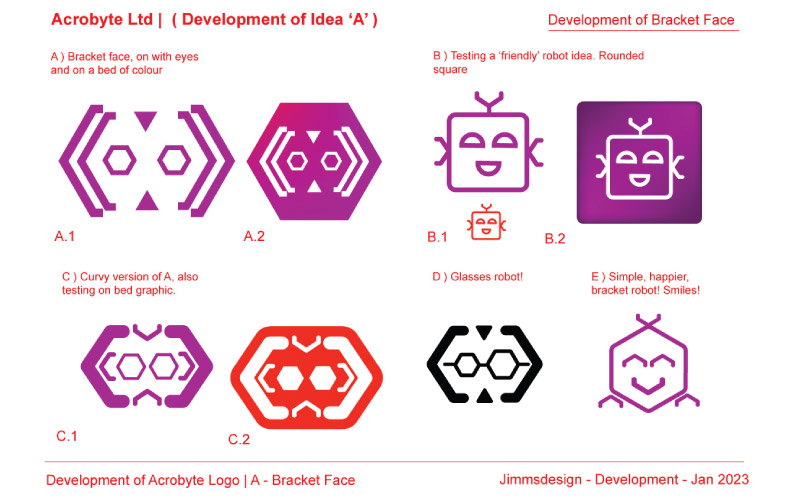
Or cover ideas
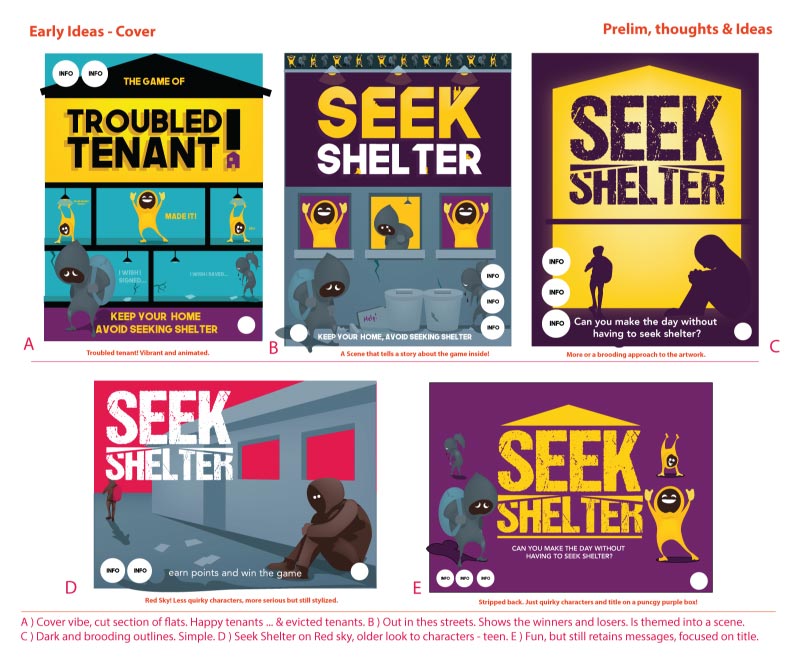
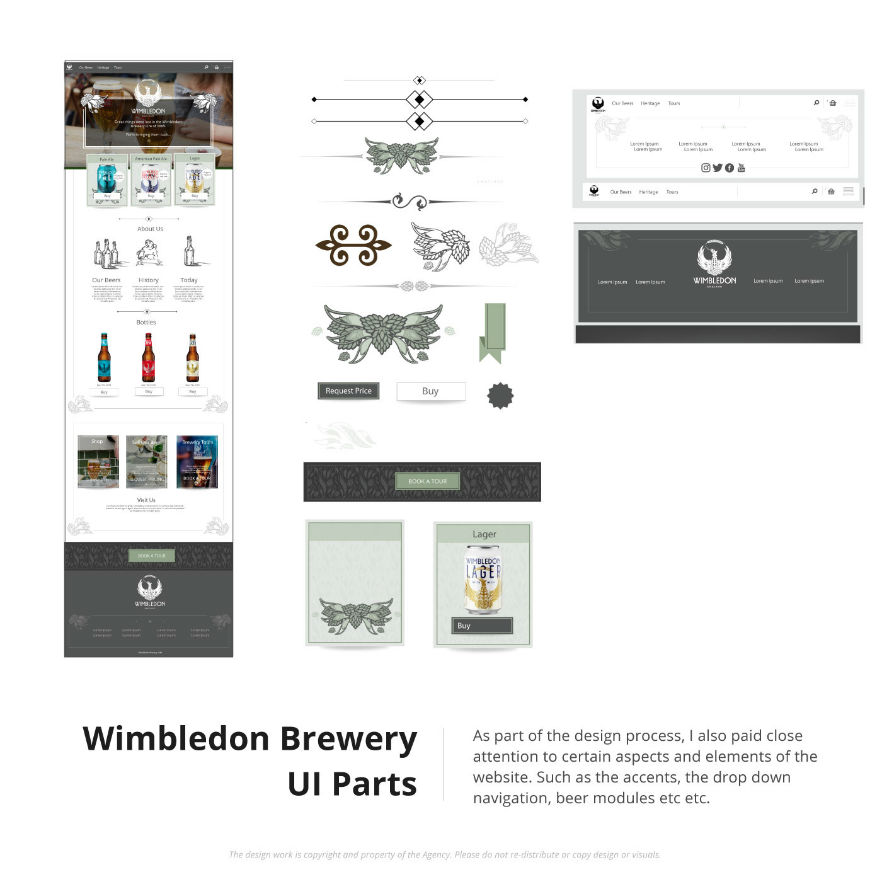
No design drafts at this stage are final or polished, nor am I precious about the proofs presented.
These first drafts are the foundational step in orienting the design direction of the project.
To further illustrate how this step works in the design process…
– With these early drafts, I will often refer to items on an art board with ‘A, B, C, D’. This is to help both me and the client to reference what design or designs we think are the strongest. It helps with communication.
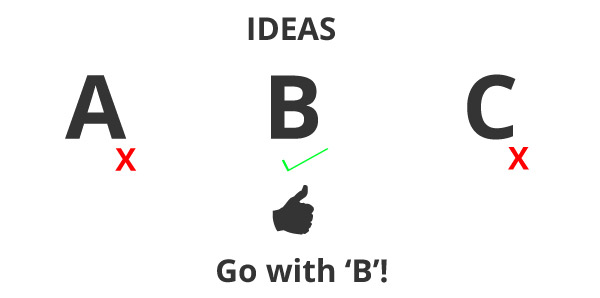
- Example 1 ) If ‘B’ is selected, I will then ‘develop ‘B’ and invest more time and energy to ‘make good’ that rough idea.
- Example 2 ) Based on this early stage of creating rough designs, if a client says they like ‘B’ with elements of ‘D’ I will remain in this phase and create another idea based on that feedback. However, the more iterations created, the more time and budget are required. If there is more experimentation, this is likely to inflate time and budget, even more so if this is repeated a couple of times.
Creative Graphic Design Process – More examples of the ‘ideas phase’
To further illustrate this idea phase, here are some more samples of what can take place:-
- Rough sketches and drawings on paper
- Rough digital drawings
- Scribbles ( Very, very early exploration of ideas )
- Initial digital mock-ups ( as proof of concept )
- Loose thumbnails ( small drawings )
- A selection of ideas with labels
- Annotated concepts showing reasoning
These are all tools and approaches required and used on a case-by-case basis for a client when working on a design project.

4 ) Developing the Initial Idea Towards A Final Design | Development
This phase is not unlike the 3rd phase on first appearances. There are, however, some key differences in this stage which ought to be mentioned.
1 idea is usually selected and developed ( built upon ). This is not the stage to be hashing out new ideas or rough ideas. If I do find myself or the client trying to create new ideas in this stage, I will inform them that I will need to roll back a step to do this.
I try to steer my clients into making idea decisions early!
As mentioned in stage 3. This is both for my own sanity and the clients, to control the flow and time frame of a project.
This is the stage of building upon the best idea and honing in on that particular idea, not to experiment with new ones. But in reality, eureka moments can come along! That is the nature of the creative journey.
2. simplify the differences between stages 3 and 4 :
- Ideas generation = to create a range of rough ‘ideas’
- Develop that idea = to improve one of the short-listed ideas
The Creative Graphic Design Process – Developing The Winning Idea!
1 idea was selected! That awesome idea for a cover, board game design, box, or something else. Now the sole focus is all in on that single idea. An idea in which all energy and concentration are now focused. The idea that is to be ‘developed’ – made good, in other words.
( Typically ) 1 idea has been short-listed and selected. This is based on client feedback and whether this idea adheres to the brief.
From here, I will take the rough design, either polish it and make good of the artwork for the final stages of the process.
Or
I will amend that design based on the feedback from the ideas stage. I will then present this to the client for approval.
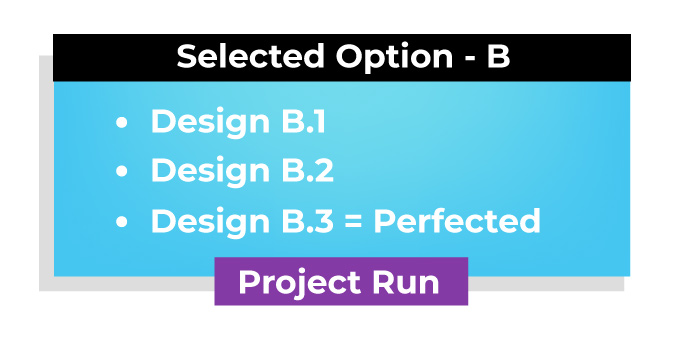

Creative Graphic Design Process Scenario… Based On Past Experiences
I wanted to share a real scenario when explaining my creative graphic design process and spilling the proverbial beans. This is not an exact re-enactment. This fictionalised scenario.
Imagine the following :
Client: “ I really like A, not B. I like elements of idea C… is it possible to combine elements of both A, C and see where this leads?”
Designer ( Me ): “I don’t see why not, I’m happy to send this version across, but it may take a bit of time to mend, and there is no saying if that will work. ”
As a side note, if I think something will look utterly terrible before doing it, I will often voice this – if they are willing to listen.
Client: “ Okay, let’s see what that leads!”
Designer: “Keep in mind that this may add to the cost. if you have more feedback as to why you feel that a mixture of the above applies, let me know.”
Client “Okay… see where it goes. I feel that X and Y work because they are closer to business intentions and, I plan to do X in 6 months.”
In this scenario, I will create another rough version to be sent to the client. Based on client feedback, I proceed from there. If the artwork is given a green light or some seal of approval. I will then take this to what is essentially the final creative stage.
5 ) Refine, Polish, Tweak ( Fine Tuning )
From the previous step, if the core of the work is ‘nearly there,’ I will then progress the design to completion.
This refining or fine-tuning stage may involve the following:-
- Slight adjustments to the alignment of objects
- Checking colours are as they should be
- Minor tweaks to the visuals
- Checking that images, etc, are embedded
- The artwork is moving towards the steps for delivery
- Morning towards file preparation
* Warning – THIS is not the stage for significant changes! *
The latter stages of a design project are not the time for last-minute changes, complete revisions, whims, or overhauls!
Doing so would require me or other designers with a similar design process to go back to stage 2 or 3 and restart from there.
This costs time and money, and big changes are best made at the start and middle, not the end.
So, don’t rewrite the brief at the end or partway through unless absolutely essential! This can be costly and can cause headaches for all concerned!
This is why I request written signs of approval for EACH stage of the creative journey. This is to mitigate and discourage knee-jerk decisions and changes at the 11th hour.
Any significant changes to the design, be it a concept, is in essence a roll-back… and will delay the project and incur costs.
Last-minute design changes happen but are best avoided for those who are conscious of cost.
Here are some reasons why, on rare occasions, this ‘does’ happen.
- The client has had a change of heart
- The client has new ideas they want to explore (late)
- Another person of control has manifested late in the project
- The client is listening to another person’s opinion ( or too many opinions )
- Something has been realised later in the project, whereby it requires changes
This is the reality of professional design. Setbacks can also arise from various external factors outside both the client’s and designer’s control.

6 ) Final Draft For Approval ( What Is The Final Draft In Design? )
When referring to graphic design, the final draft will represent the final form and iteration of that particular design. The final green light!
A written sign of approval, such as ‘greenlit’, ‘complete’ ‘finalised’, or anything in written form to say they are explicit in their satisfaction with the work. Then it is the next step of packaging the design project for handover.
*For myself and as part of my professional service. I will require a client to give a sign of explicit written approval.

7 ) Package Deliverables – Give it to the client – Handover
The very last step in my creative graphic design process, and something that should be included if the process is to be told in full.
Packaging up your project and handover.
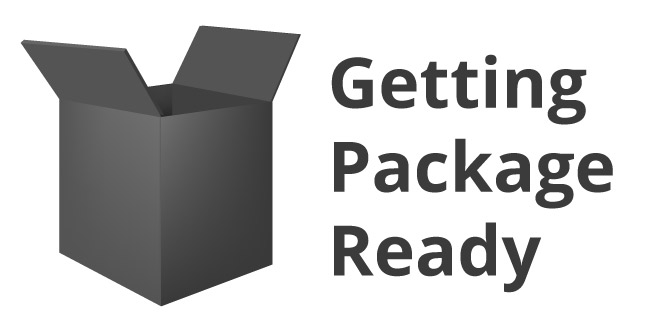
Handover will take place once I have been given the very last sign of approval, and my final invoice has been paid. Once this has all taken place, generally, I will ‘Zip’ the project assets that the client needs and transfer the final artwork to the client.
To further illustrate what this package may contain, it may resemble the following :
JPGs, PNGs, PDFs, Illustrator (AI ) Files, and Photoshop files (PSDs) to name a few. It will depend on what is written in the brief and what the client requires.
This should be stipulated in the ‘specification and agreement’ at the start.

Question | Are there factors that can impact the design process?
My creative graphic design process, like other design processes, can have factors that impact it, as mentioned throughout this post. For example, if there are multiple parties involved in the approval, this can extend the budget required.
Change in project scope partway through a project can impact it, and very human factors can impact it. Such as a client being unable to pay, sickness, or general personal reasons from either party.
Final thoughts about my graphic design process
Avoiding misunderstandings is a priority. Both for my benefit and for the clients. As this post is to highlight and illustrate how my creative process works – I should also draw your attention to how the actual journey and design process can manifest in the real world.
The path is not a straight line…

It is more of a meandering path of process of elimination, whittling down the design ideas so only the strongest are left for selection.
You could also say it is reminiscent of a carving. You may begin with building up the materials and layers for the base form. Once this is set, it can be a case of reducing the form until the final artwork emerges.
For those who are interested, you may be interested in reading this article on a design journey or reading a bit more about the design process as a general overview.
Now let’s design something!

Creative Graphic Design Process – Other Useful Links
- Design journey
- What is a design process ( general detail – Graphic design )
- Project: Creating a brand narrative
- Case Study – designing a party board game
- Retail packaging examples
- Aardman Project – Packaging concept
Creative Process 3rd Party Links and Sources
External Design Website – Jimmsdesign.co.uk
Credits & Education
Education Source – https://www.cumbria.ac.uk/
College – https://www.aup.ac.uk/
My Adventure Creator Project | Lockdown Foray
My Adventure Creator project…
For those of you who don’t already know, at the start of the lockdown, I set myself the task of creating a graphic adventure game! Or, I should say, I started to learn how to make a graphic adventure game in Unity.
There was a time in Lockdown – what can I say!
For those of you who don’t know me, I studied Multimedia Design and Digital Animation as a follow-up course to my HND in Graphic Design at university. All those years ago! I also have a yellow belt cert in Unity too.
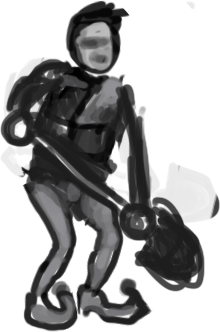
In the early days of the 2000s, Adobe Flash was king, ( Check this blog post out on why to avoid Flash player on another website ) and I used to make a lot of multimedia applications, both personal and commercial. Most of these early projects were micro games or small interactive animations – all of this stuff was pre-smartphone.
My first project on this sort of scale, where I had to try and create my own project, was at University. I set about making an e-learning game for children, which was all built in Flash. Sadly, with the demise of Flash Player, this is tricky to play now although I may still have a projector for the game somewhere.
Here is a picture of it.
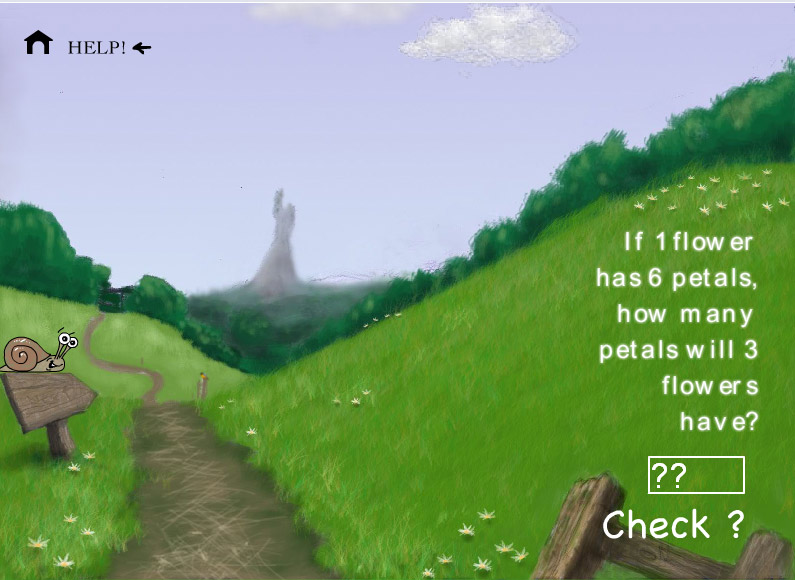
From a game creation perspective, In hindsight, really it was a narrative game with educational elements to it. You may also be interested to see in theory how to make a story game in Adobe Animate.
But now to the crunch.
Adventure Creator Project.

Adventure Creator Project | Fools Errand
A name for a game that exists solely as a learning exercise – it could have been called anything really, as I had no intention of monetizing it. The game was based on classic 2D point-and-click graphic adventures that you could buy in the 90’s – the humble point and click game.
You point… and you click.
I created this game a greybox prototype to see how Adventure Creator works. It was something to learn during the Lockdown.
The brief – Learn AC.
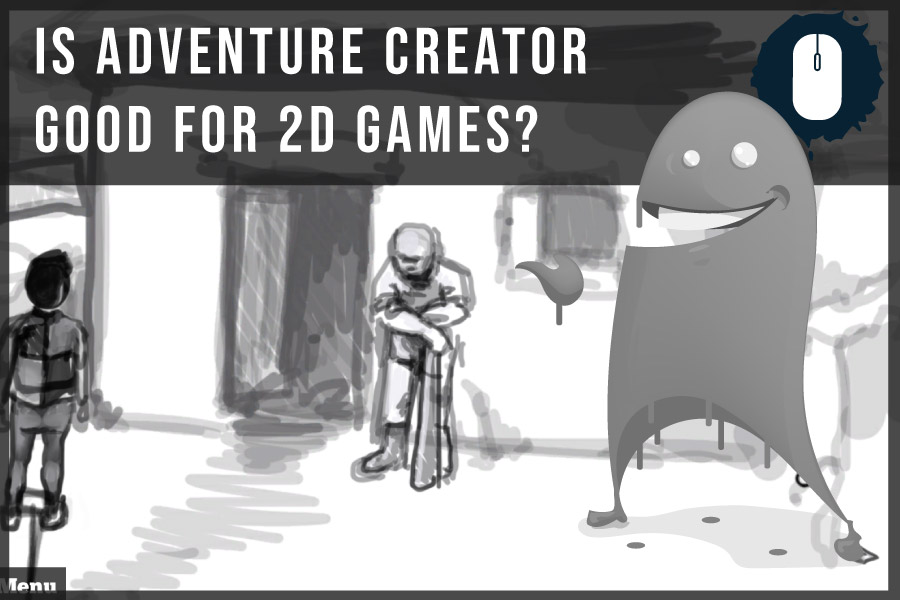
If you are interested, you can play the game on itch.io. It is free to play with bugs and all. ( however, it should be noted that you can’t save it via the browser version )
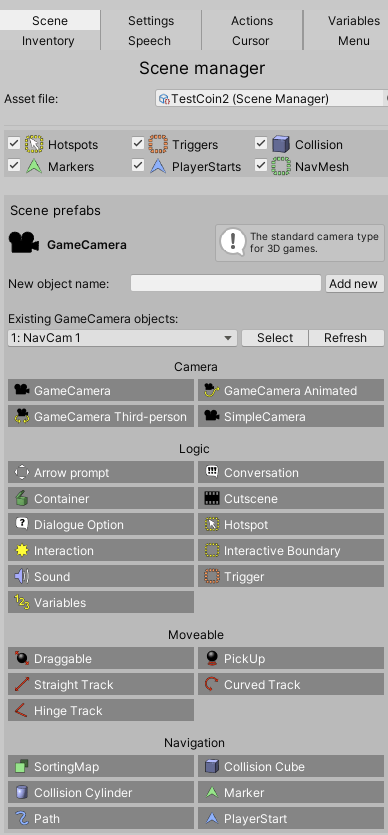
Do I think Adventure Creator with Unity is good?
‘I’ think it is great.
Actually, saying AC ( Adventure Creator ) is good is a massive understatement. It is excellent, I have never been able to assemble a graphic adventure game in the most time and cost-effective way until I used AC. The standard that Adventure Creator offers is just excellent compared to some of the game engines or tool sets I have used in the past.
I have written a post about it on this website – is Adventure Creator good for 2D games on game-gunk.com.
What is my Adventure Creator Project about?
I called it Lost Hat, AKA Fools Errand. The title leaves very little to the imagination of what you need to do.
Who knows where the hat got to?
Or who could be wearing it!
Oh, the trifles of life.
You will need to use your wits to get through this 3 level game to find your hat. Perhaps if I see enough people play it, I might write up a shot hints and tips guide. But I have largely moved on to other things.
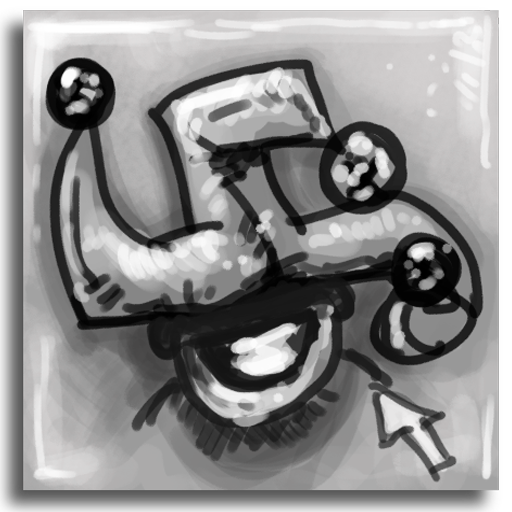
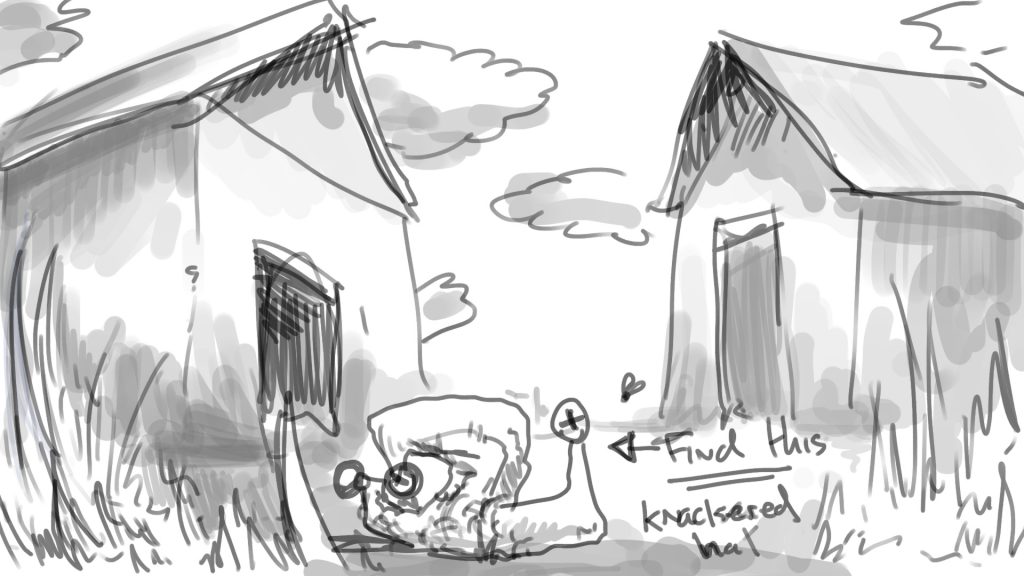
The components of the project – AC ( What was involved )
For a personal development project – more than I would care to admit.
This project has a of artwork, basic 2D animation created in Photoshop, some rough and ready characters, Sprites and sprite sheets, sound effects, dialogue, conversations, and logic, and I’ve even decided on a small video clip at the end of the project to see how that would work too. And, of course, Adventure Creator. To summerise it is best to mention it this way.
- NPC character sprites
- Player character sprites + and custom animations spites
- Background artwork
- Scene and item artwork ( such as coins )
- UI design
- End scene video animation ( video )
- The AC logo for every object and item that can be interacted with in the game
- The Icon artwork
- Writing all the dialogue for the game
- SFX
Adventure Creator Project | Sprites
The sprites, or the characters, however you’d prefer to see them, comprise of all NPCs, the animals, the main player, and various other bits and pieces that were used in the environment. If it moved or was animated, it was probably a sprite.
To quickly paint these characters in various states of animation, I used Photoshop to sketch and brush in the black and white ‘wash’.
The main player in particular has a 4-way direction and various other obscure animations in its repertoire!
The main player was the most time-consuming to create, even as a rough sketch. 8-direction would have taken more time still.
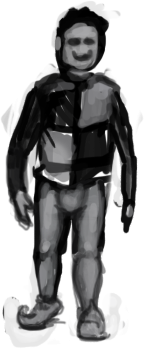
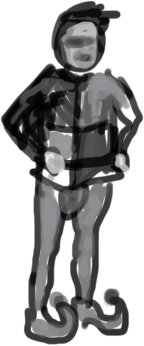
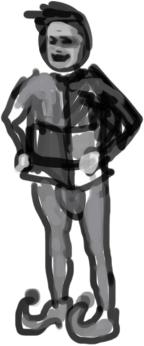
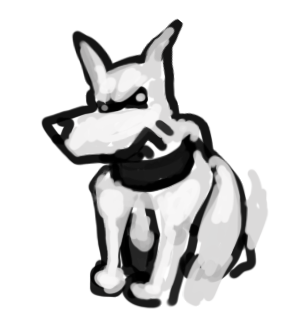

Adventure Creator Project | The Scenes
I don’t wish to spoil too much of the game just in case you do decide to play it, as there are only three levels. But in each level, there was a background image that was quickly drawn in Photoshop and then imported as an asset to my project.
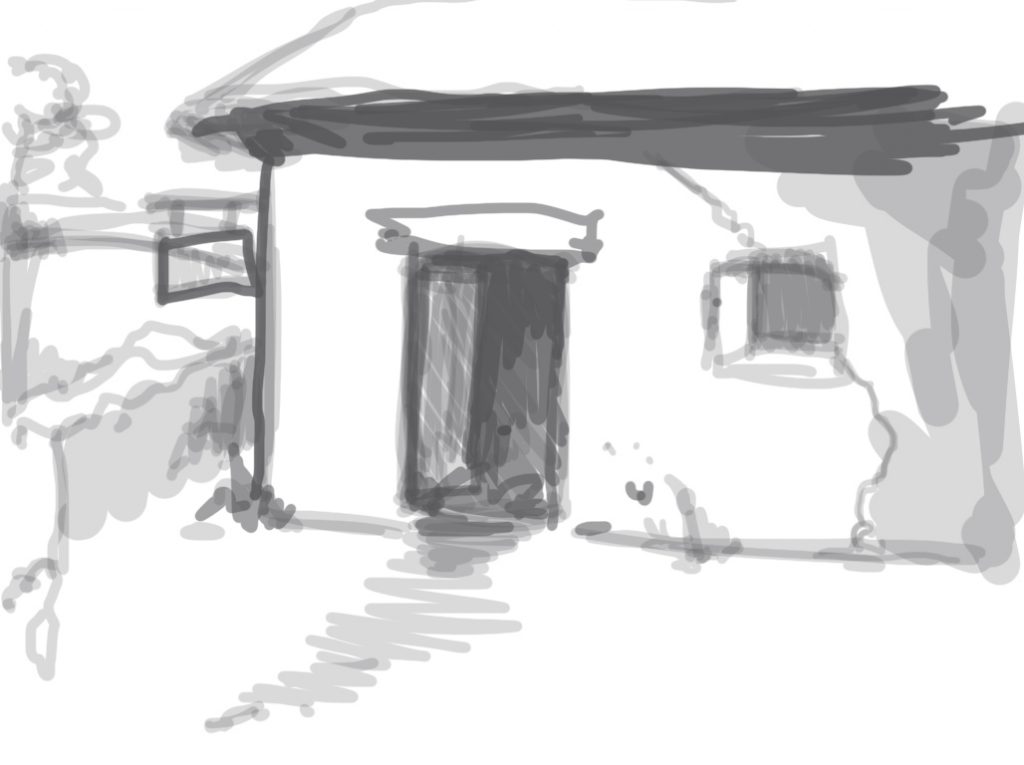
Adventure Creator Project | Motion & Animation
I gave very little time to the motion graphics and animation sadly.
After all, I needed to think about the project as a whole and produce this game it quickly. I was invested more in the learning of Adventure Creator than the actual product itself. However, creating some basic frame-by-frame animations was still essential for making the sprites.
To create basic in-game animations, I used Photoshop and painted a couple of layers with my Wacom Tablet as if I were to make a GIF before exporting out the layers as frames.
How did I feel about the project?
As a semi-personal project learning experience, I feel pretty good about it. This was never going to be a polished game for the whole world to play. I created it so I could learn and share. It was undertaken during the Lockdowns. It was a grey boxing experiment.
The project as a whole, taught me more about AC and how I could potentially create a bigger and bolder game in the future using Adventure Creator.
You can play the game here on Itch.io if interested. Warts and bugs included ( you can’t save via the browser version ). It should be noted that the browser version of the game won’t allow you to save! Enjoy. Or you may find some information on this website interesting if you are at game projects.
You may also find this subject on game-gunk interesting: is Adventure Creator good for 2D?
Without divulging too much. I’m currently remaking an old project in Adventure Creator.
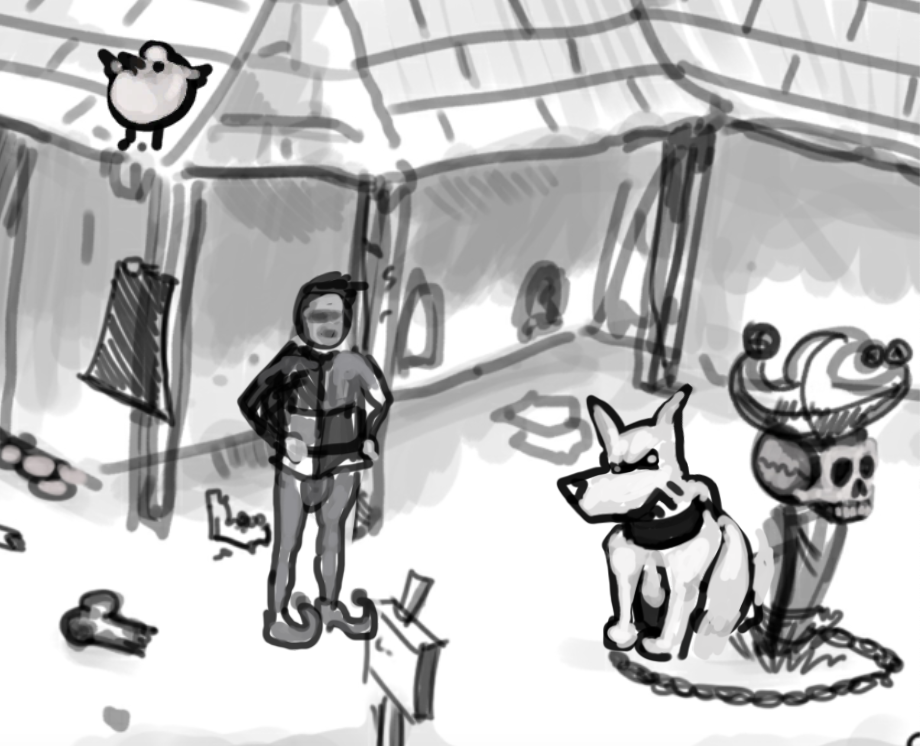
Adventure Creator Project – Other subjects around making games
Okay Aardman! Wallace & Gromit Project
Aardman Wallace & Gromit Project – flex those Adobe Illustrator muscles. I have a new post to share… kindly, the team over at Paper Engine has now said that I can share and discuss my part in creating some of the packaging concepts for a new range of Wallace & Gromit themed products.
The artwork shown in this post was used to pitch to Aardman for a new range of British designed card products, otherwise known as – Build Your Own, For Paper Engine.


Aardman Project | The Brief
The Brief | I was commissioned by Paper Engine to help create the core design for the packaging concepts for a new range of of Wallace and Gromit themed paper products.
Aardman had set up an agreement with Paper Engine for them to come up with a range of products, themed around Wallace & Gromit.
If you don’t know Aardman, they are the animation studio behind Wallace & Gromit, Chicken Run, Arthur Christmas, and Shaun the Sheep to name a few.
Paper Engine got in touch with me and asked for assistance in coming up with the core packaging concept to pitch to Aardman.
I won’t lie, I was excited and honoured.
Under a strict NDA, I was called in to help come up with some of the core concepts for the new eye-catching packaging.
The NDA has been relaxed now, as the products have been released onto the market. So don’t worry. And I asked the crew over at Paper Engine and they were happy to allow me to show my my part!
(All artwork on this page is the intellectual property of Aardman and Paper Engine. Do not copy, save, or download any of this content for commercial use ).

Packaging For Paper Engine… Which was actually for Aardman
To spill the beans on the projects.
Here is a bit of extra information on the project process. Once Paper Engine had sent the brief across to me, and we did all the admin, the project was set in motion!
Aardman Wallace & Gromit Project | The design process involved…
- Coming up with some very early ideas for speech bubbles, titles, typography, backgrounds, and other accents and parts for the project.
- Creating a variety of packaging front ideas for both products.
- Developing rough designs into polished designs.
- These were presented to Aardman ( gulp ).
It should also be said that this project was quite particular and that there were 2 companies involved in the approval process. Nonetheless, it still allowed room for design creativity.






Aardman Wallace & Gromit Project | Developing The Design
While I was allowed to work conceptually and creatively, I also had to adhere to 2 sets brand guidelines! One set was supplied by Paper Engine for Paper Engine and, the other was for Aardman!


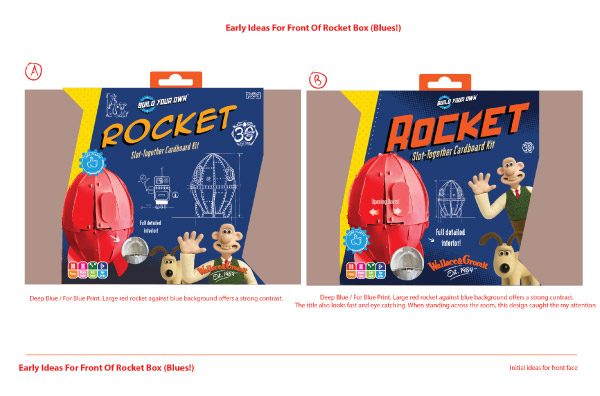

Aardman Wallace & Gromit Project | The Delivery
After working on the polished designs, Paper Engine pitched the artwork to Aardman. I was told on the grapevine that they were pleased with the project – with very few changes to the pitch!
Thank you Paper Engine, it was an honour! From there the look and feel for the range was set. It was an awesome project.
How I approached the project
When creating the packaging, I tried to create artwork that was exciting and matched the tone of Wallace & Gromit. I also tried to create packaging concepts that would excite both children and adults if they saw them on the shelf!
‘wow look at that!’
type of thinking with the hopes somebody would pick the product up and purchase it. The product did most of the selling in all fairness, these are very cool products.
Aardman Wallace & Gromit Project | Paper Engine Testimonial
‘We worked with Jimm on some early packaging concepts for our collaboration with Aardman on three Build Your Own kits. He delivered some superb designs which enabled us to get ahead of the curve by keeping the client on board with approvals and saved us some valuable in-house studio hours. We would definitely work with Jimm again in the future when the occasion arises. Top marks. 5 stars.’
Geff – Creative Director, Paper Engine Ltd.
Aardman Wallace & Gromit Project | You may be interested in some of the following
Retail packaging projects
Stem Project samples
Snakes & Ladders type board game
Board game playtesting post

3rd Party
Working with beta testers for your board game – a story of Beta testing
Working with beta testers… creating board games isn’t easy! A crucial and oftentimes overlooked stage for creating a commercial board game is the beta and alpha testing.
I was commissioned to create a board game prototype to teach children about youth homelessness. My primary role was – mostly – visual design and gameplay, and illustration. And… consulting and guidance on creating a game.
When working with Beta testers, I tried to create an environment that was open and invited constructive feedback.
While I took notes, I allowed the Beta testers to play how it suited them to play. Down to opening up the initial black packaging box to reading the rules, in whichever order they chose.

Setting up the Playtests for a board game prototype
This was my first playtest in quite a while. In the past, I have been involved in both helping to set up alpha testing and the follow-up stages of a Beta test. Beta testing on behalf of a 3rd party client was a new experience for me. And there was a lot involved.
Before preparing 2 different environments for beta testing. I had to get the testers to sign NDAs on behalf of the client.
It should also be noted that a large amount of effort was involved to find both beta testers, and finding a space to carry out the beta testing. Money also needed to be paid to the venue for lunch.
Alpha Testing vs Beta Testing
There are some key differences in the alpha and beta testing stages. With alpha testing, this is often a case of a game or game prototype being experimented with and developed internally. In my case, I was the first tester of the rules. I created the rough rules to see how the game mechanics may work and wrote these down as I went along. This is typically the very early stages of creating a working board or card game. The more alpha testing you can do before going to external beta testing, the better.

Beta testing the game involved finding other parties to look at and play the game. These people had never read the rules or knew what the game was or anything. Once I sourced the beta testers, found spaces to play the game – this then set about into motion the gameplay.
The beta stage is the more developed stage of creating the game prototype.
Creating the gameplay | My experience of working with beta testers
I was involved in creating the initial gameplay as well as working on all the visual design for game. This was part and parcel of the commission of the game project – from top to bottom. Finding board game testers can be tricky ( external website on finding beta testers ) , but I feel that these beta testers offered tremendous value to creating the board game prototype.
Here are some initial screen grabs from the playtest. An important stage when creating a board game prototype.
The first draft low-fidelity prototype


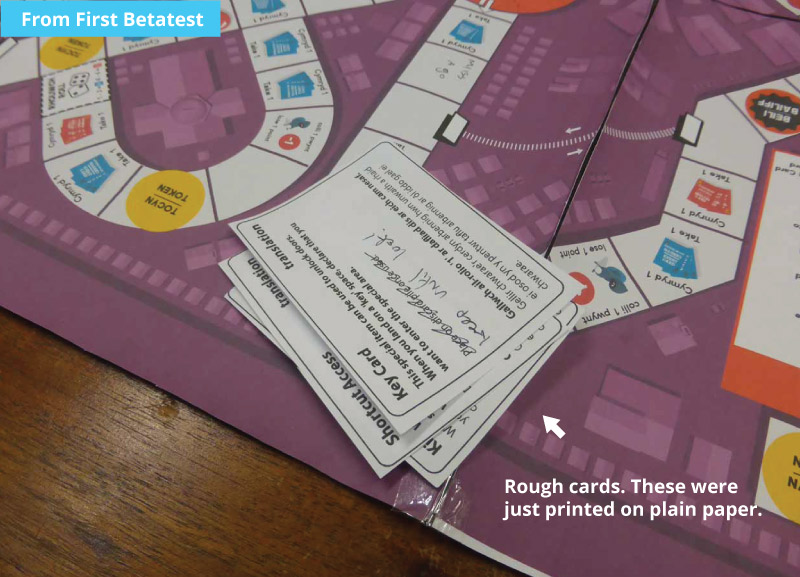
The later stages of the playtest | working with ‘other’ beta testers
I would advise when doing a playtest of your game, to try the game on people you don’t know. ( although I do know Paul here – thanks Paul, Paul is also a drummer I’ll have you know! ) The wider the pool of people… the better. Below are some visuals of the playtesters in action doing their thing!
And me… taking notes on how the game is being played.
Doing these live tests is not always easy on the ears. But they can be essential for making a better and more rounded board game.



A special thank you to the playtesters for this game
This lot should be proud – although the Conwy Council may not know the names of the playtesters I would like to announce who helped make the prototype a more rounded and playable experience.
( me, I was the first tester ) Faye Willets + Family, Helen Edmonds, Jake Joung, Paul Whibley, Steve – and a Special thank you to Liz Chadwick for introducing me to some fellow playtesters!
If you would like any advice or a design service to design your board game you can read more here – freelance board game designer
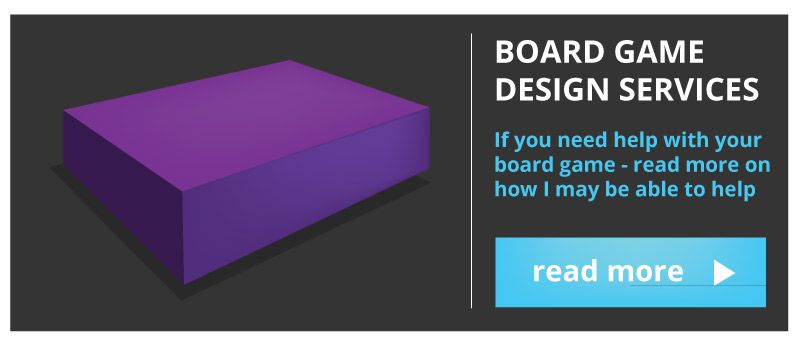
Are you a playtester?
If you are a playtester for board or card games? Feel free to drop a message across with a bit about you, what you do, where you are based, age, your demographic, and the types of games you like to play. ( please note that many of my playtesters are currently based in the South East – UK )
Are you looking for playtesters?
Playtesters or beta testers can be tricky to find if you are just starting out. This article here on Dragon Bone games About finding playtesters may be helpful – ( Alpha ). Or if in the later stages of development – where to find Beta Testers. ( external website )
Notes – On Prototype
It was a fun project to work on. I would like to say I have no idea what the mass production or future edition of the game will look like but either way – I was happy to be part of the pre-first edition of the gameplay.
Are you looking to create a board game? I was involved in the visual look and feel of the game along with the vector character illustration. Feel free to get in touch if you want to discuss your game project!
Tips For design around board games
- How to edit game card text in Indesign
- Drawing with a stylus on a computer
- Dino break
- Creating The London Pub Crawl
- Portfolio – Packaging examples
- How can you sell a board game

3rd Party websites – External
- Freelance vector illustration ( jimmsdesign)
- Board game design in London and South East area ( jimmsdesign)
- How to make a board game prototype – Dragon Bone Games
- How much does it cost to make a board game? Dragon Bone Games
- What does it cost to make a TTRPG – Dragon Bone Games
Jimmsdesign – Game content and design Copyright Conwy Council and its respective partners ( artwork shown for portfolio purposes only )
